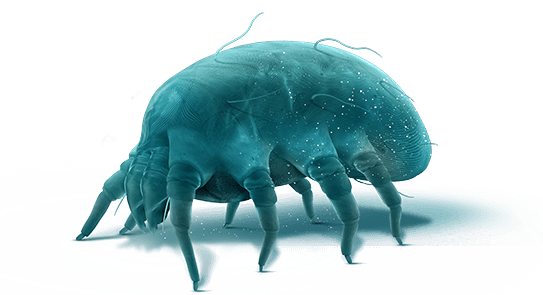
What are dust mites?
Related to arachnids
Nearly invisible to the eye, dust mites are about 0.2 to 0.3 mm in length. They have eight legs, like spiders, ticks and other members of the arachnid family. Dust mites are also very common: most household mattresses hold around 2 million of them. Apart from causing allergic reactions in sensitive people, dust mites are harmless to humans. They are not bed bugs, and are not related to bed bugs.
![]()
Found in warm, dark, humid environments

Dust mites are found in homes around the world, particularly those in warm, humid climates. Because dead skin cells are their primary food source, mites prefer to live in mattresses, carpets and upholstered furniture that people use frequently. They prefer temperatures between 20 and 25 degrees Celsius and humidity levels between 60 and 70%.

Dust mites eat dead human skin cells
Perfer to live in mattresses
Mattresses are the ideal environment for dust mites, as human sweat increases the humidity of the mattress and serves as a continually renewing food source. At night when it’s dark and a sleeping human body increases the temperature of the mattress, dust mites migrate to the surface to feed on dead skin cells. They leave their shells and excrement behind. Before sunrise, they return to the deeper layers of the mattress where they are completely protected. To minimise water loss during the day, dust mites release compounds called aggregation pheromones that enable them to sense each other and group together at the core of the mattress.


Every night, dust mites migrate to the surface of the mattress to feed
Reproduce rapidly
Dust mites only live about 2 to 3 months, but they reproduce very quickly. Female mites lay between 20 and 80 eggs during their lifetime, and every mite produces 20 droppings daily. Eggs hatch after 6 days, releasing mobile larvae. In 3 to 4 weeks, young mites pass through different developmental stages, shedding their shells after each stage. Larvae become nymphs, and then pass through an additional nymph stage before becoming adults.

Because every female dust mite lays 20-80 eggs, the mite population in a bed can explode from 1 to 1,000,000 in just a few weeks
Allergen producing

Unlike bed bugs or other forms of parasitic mite, dust mites do not bite or puncture the skin. Dust mites are not allergens themselves, but their shed exoskeletons and droppings contain proteins that cause allergic reactions in sensitive people. Symptoms range from allergic rhinitis (runny nose, congestion), conjunctivitis and atopic dermatitis to asthma, and can be severe in some people.

A double mattress may often contain 2,000,000 dust mites producing a total of 40,000,000 droppings per day
Allergy symptoms become more severe when more allergens are present in the environment. Reducing the quantity of allergens relieves symptoms and can even eliminate all clinical signs.
Learn more about dust mite allergy and treatment.Download the dust mites allergy ebook!
This ebook gives you essential information on dust mite allergy and existing solutions for a better day-to-day management of your allergy.